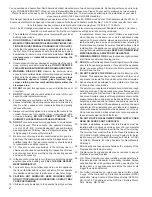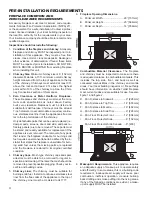
5
a. Existing fuel-fired equipment shows evidence of
back puffing, smoke roll-out, inefficient operation,
or excessive smell in the living area.
b. Opening a window or door alleviates any of the
above problems or symptoms.
c. The building is constructed with a well-sealed va-
por barrier, tight fitting windows, or has powered
exhaust fans.
d. Excessive condensation on windows in the winter.
e. The building has a ventilation system installed.
f. If, once installed, the solid-fuel appliance does not
draw steadily, burns poorly or inefficiently, back-
drafts or experiences back-puffing when adding
fuel.
VENTING (DRAFT) REQUIREMENTS
The chimney flue is a critical component to the proper and
efficient operation of any heating appliance. Heating appli
-
ances do not create draft, draft is provided by the chimney.
This appliance requires a draft of 0.05 in. water column
(0.1 Pa) at the flue collar.
WARNING: RISK OF FIRE - EXCESSIVE DRAFT CAN
CAUSE OVERFIRING AND A POSSIBLE STRUCTURE
FIRE. DO NOT OPERATE THIS APPLIANCE WITH
THE FLUE DRAFT EXCEEDING 0.06 in. w.c. (0.1 Pa).
To achieve proper draft, your chimney must meet three
minimum height requirements; minimum height from top of
appliance (15 ft. total height from top of appliance), minimum
height above roof penetration (3 ft.), and minimum height
(2 ft.) above highest point of roof within a 10 ft. diameter
from the chimney.
The chimney must also meet minimum and maximum
cross sectional requirements. For that reason a continu
-
ous 6˝ stainless steel liner from the flue collar to the top
of the chimney is required. A stainless steel adapter is
recommended for fastening the stainless steel liner to the
flue collar. The male (or crimped) end of the adapter must
be installed inside the flue collar to allow condensation or
creosote in the liner to drain back into the firebox. Chimney
liners and/or adapters must be permanently fastened using
a minimum of three (3) screws at each connection.
Chimneys outside of the home or on an exterior wall are
difficult to keep at operating temperatures and may result
in increased creosote buildup, less draft, back drafting
problems and poor appliance performance and should be
avoided.
FLOOR PROTECTOR
A solid non-combustible floor, concrete or solid masonry,
must extend 6˝ to either side of the body of the appliance
and 12˝ in front of the face of the appliance.
When combustible flooring falls within these minimum
dimensions, it must be covered with a listed floor protec
-
tor meeting the requirements of UL 1618, such as Hy-C
or Imperial Model UL 2840BK or equivalent with 0.84 R-
factor, 1” thick. (Note: to calculate R-value of alternative
materials see
Floor Protector Material Calculations
at
the back of this manual.) A grouted ceramic floor tile that
meets local building codes and the minimum 0.84 R-factor
requirements is considered a durable equivalent.
PRE-INSTALLATION REQUIREMENTS
WARNING: RISK OF FIRE - DO NOT ALLOW COM-
BUSTIBLE MATERIALS (CARPET, FURNITURE,
FUELS) TO BE PLACED ON OR COVER THE FLOOR
PROTECTOR. ALL COMBUSTIBLE MATERIALS MUST
REMAIN OUTSIDE OF THE MINIMUM CLEARANCE
DIMENSIONS.
US - 38 inches [965mm]
CAN - 42 inches [1.06M]
US - 6 in. [152mm]
CAN - 8 in. [203mm]
US - 6 in. [152mm]
CAN - 8 in. [203mm]
12 inches [305mm]
FLOOR PROTECTOR
Minimum Floor Protector Specifications
Содержание Country Hearth 2200IE
Страница 17: ...17 NOTES...






































